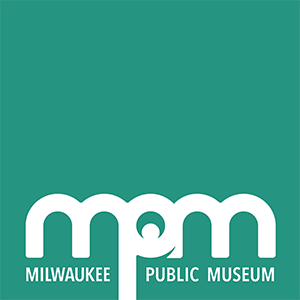Introducing Our Museum's New Name and Logo, Launching in 2027
In 2027, Milwaukee Public Museum will move into a new, state-of-the-art building featuring the immersive experiences and awe-inspiring dioramas we're famous for. At that time, we will also change our name from Milwaukee Public Museum to the Nature & Culture Museum of Wisconsin. A stylized version of our new iconic building design will become our new logo.
The Nature & Culture Museum of Wisconsin will be located in downtown Milwaukee at the Milwaukee Museum Center on the corner of North 6th Street and West McKinley Avenue and will continue to proudly display and care for the priceless Milwaukee County collections.
Our treasured 143-year-old institution will continue to live by the same mission to inspire curiosity, excite minds, and increase desire to preserve and protect our world's natural and cultural diversity through exhibitions, educational programs, collections, and research.



Our New Name
Defining What We Are and Who We Serve
What does "Nature & Culture" mean?
For more than 140 years, this institution has been a natural history museum. And we will continue to be a natural history museum when the Nature & Culture Museum of Wisconsin opens. But if you've ever wondered what a natural history museum is, you're not alone. We'd like to help answer that question with our new name.
A museum's collections dictate what kind of museum it is. Our Museum has more than 4 million collections items in its care, both specimens (i.e., plants, animals, fossils, minerals) collected in nature and objects (i.e., tools, weapons, textiles, vessels) created by people from different cultures around the world and throughout time. Behind every specimen and object is a story that we share through our exhibits to educate our visitors. Many of these stories have both a nature and culture component that showcases how the natural world influences humans and how humans influence the natural world. We have been and will continue to be a natural history museum, or more clearly put, a Nature & Culture Museum.
Take a look at some examples of this nature-culture connection found among our collections items and how they'll be displayed in the new exhibits.
Why are we a "Museum of Wisconsin"?
You may be wondering why we're replacing “Milwaukee” with “Wisconsin” in our new name. While most of our visitors were initially from Milwaukee when we were chartered by the state in 1882, more than 140 years later, our reach has expanded across all of Wisconsin.
So how Wisconsin are we? We are the most visited museum in the state. We have collections items from all 72 counties. Our new museum will have exhibits that showcase the natural wonders and diverse cultures found throughout Wisconsin—and that includes the expansive Milwaukee Revealed gallery that will explore the city we will continue to proudly call home. We are truly a statewide institution with the good fortune of being located in Milwaukee.



Our New Logo
Inspired by the Building's Iconic Architecture
At the center of the new logo is a stylized version of the Museum's iconic new building, which was inspired by the magnificent rock formations at Mill Bluff State Park in central Wisconsin—bringing elements of this natural landmark to the heart of Milwaukee.
The logo's uniquely rounded edges also echo the curvature of the new building. Like our building and logo, square corners rarely exist in nature.



Our New Colors
A Nod to Wisconsin Nature and the Museum's Collections
From our waterways to our textiles, the Nature & Culture Museum of Wisconsin's colors are inspired by the hues found in nature in Wisconsin and by the global artifacts and specimens found in the Museum's collections.
Primary Color Palette

Red Ocher
Ocher, a hue found in the Earth's minerals, has long been used by humans as a pigment in pottery, jewelry, fabrics, and more. As the main color of the brand, it represents the longstanding relationship between humans and their natural environment.
Click on the color swatches to learn about our primary color palette.
Secondary Color Palette
While the primary palette is specific to Wisconsin, the secondary palette is specific to us. You'll see both bright hues and earthy tones, all taken from various natural specimens and cultural artifacts in the Museum's collections.



Our New Look
The Brand in Action
Check out how our new name, logo, and brand colors will appear online, in print, on signs, and apparel.



A New Place to Connect, Educate, and Inspire
Throughout our 143-year history, we have become one of the most innovative and respected natural history museums in the world and the most visited museum in Wisconsin. With our new building opening in 2027, we have the exciting opportunity to continue our legacy of pioneering research, preservation, collaboration and education with a new name and logo that better reflects what we are and who we serve.
The Nature & Culture Museum of Wisconsin represents our prominence as a statewide institution and identifies us as a museum that explores the relationship between humans and their natural environment throughout time.
FAQ
Why is "Milwaukee" no longer in the name?
The name “Milwaukee Public Museum” has served us well through the years, but it is no longer an accurate representation of who we are. While the Museum is in Milwaukee, it serves people from across the state. In fact, half of our Wisconsin visitors come from outside Milwaukee County. We are truly a statewide institution, serving all of Wisconsin, and our new name will reflect this. In addition, our building design was inspired by the rock formations at Mill Bluff State Park in central Wisconsin, and our new exhibits will explore the natural and cultural wonders found across our state. Despite this change, those of us who live and work in Milwaukee can still be proud that this world-class museum is located within our city and will be another reason people from across the country will want to visit.
Why is "public" no longer in the name?
Just like our current Museum, the new Museum will be a welcoming place for everyone, but we are not technically a public museum like we were decades ago. We were once owned by the City of Milwaukee and then by Milwaukee County, but Milwaukee Public Museum became a separate private 501(c)(3) in 1992. Calling ourselves a public museum implies that we are still a government entity or get most of our annual operating support from the government. Neither case is true.
What will be the ownership structure of the new Museum?
This institution has called three different buildings home since it opened in 1884. During this time, the Museum has also changed ownership. It originally began as an entity of the City of Milwaukee. Later, the City transferred ownership to Milwaukee County. In the 1990s, MPM, Inc., a private nonprofit, took over management of the Museum while continuing to operate the Museum in the same County-owned building and care for the County-owned collections items.
When the Museum moves into its fourth location in 2027, the ownership structure will change once again. The Nature & Culture Museum of Wisconsin will be a privately owned building, run by a private nonprofit, which is how most museums operate today in the US. Milwaukee County will continue to own the collections items, which will be housed at and cared for by the Museum.
When will the new name and logo take effect?
The new name and new logo apply to the new Museum that will open to the public in 2027. The current Museum will continue to be called Milwaukee Public Museum (MPM) and will use the current logo and branding until MPM closes, which is expected to be in late 2026.
What is the Milwaukee Museum Center?
The Milwaukee Museum Center encompasses the entire complex at 6th and McKinley streets, which includes the Nature & Culture Museum of Wisconsin and its numerous amenities, including the Daniel M. Soref Planetarium, Puelicher Butterfly Vivarium, Bucyrus Rooftop Terrace, a café, parking structure, as well as the outdoor commons area called the Plaza. The Center is also where the Milwaukee County collections will be cared for and prominently featured in the Museum's exhibits.
Photo of Ragged Rock in Mill Bluff State Park used with permission from Skillet Creek Media.

